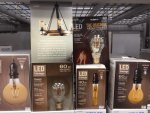That I do agree with, if the question is which is better, then why is it better has got to factor into the answer.
Agree, and post #28 addressed some of the why.
Maybe a pros/cons thing:
Pros for new fixture:
~ Designed to maximize use of LED bulb light output and dissipate heat
~ All new fixtures dont have broken/missing/aged parts
~ An entire new fixture eliminates the chance that it's just a lamp out in the old
~ Do not have to be rewired, using the original ballast, or bypassing/converting to line voltage
~ Have a warranty and is the better option of the two
Cons:
~ Much more expensive than just a drop-in bulb (parts)
~ May not be needed if existing fixtures are/were well maintained and not very old
~ Will not match the look of the existing, which can be an eyesore
Pros for retrofit:
~ Cheaper than new fixture
~ Likely to be a substantial net gain in light over the old fixture (i.e. "good enough")
Cons for retrofit:
~ May void original UL listing of the fixture
~ May not fit if more than a bulb (new reflector)
~ You're stuck with half EOL parts in existing fixture. I would not warranty the install past parts for that reason
~ Depending on the design, it could take considerably longer to modify/rewire/repair the existing fixture than to replace it
~ There's numerous retrofit designs: drop-in bulbs that use the original ballast, line voltage, etc. which leads to
~ Possible incompatibility issues with existing ballast. This seems more prevalent with fluorescents than HPS/MH fixtures.
~ Assumes all existing fixtures have factory ballast or properly matched replacements in the first place. You know what they say about assumption...


